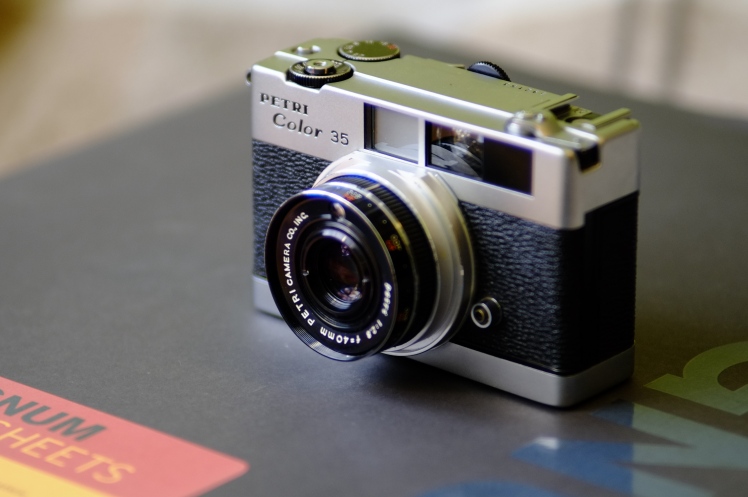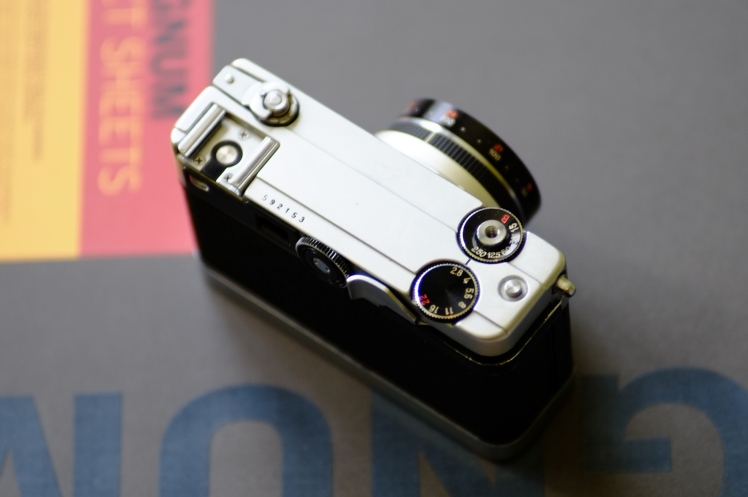Like so many other cameras I’ve had here at Filmosaur HQ, this little Petri came to me with a problem: the shutter was stuck. Fortunately, my guess that it would be a relatively easy camera to take apart and revive proved correct, and I was left with a nice, clean, and functional example (well, except for the meter – I discovered corrosion in the wire from the battery compartment, and repairing it would require major disassembly. Not feeling it worthwhile or necessary, I left it alone).
The Petri Color 35 is about the same size as the Rollei 35, and like the Rollei it’s an unusual design, though very much in its own way. The Petri is designed around the idea that the photographer should be able to operate all the controls while looking through the viewfinder, something that apparently never entered the minds of the Rollei engineers. The lens retraction and focusing mechanism is actuated by turning a wheel on the back of the top plate, with the focus distance displayed on a scale across the bottom of the viewfinder. Shutter speed and aperture are selected by knobs on the right side of the top plate. While neither of these has a display in the viewfinder, the meter does, and it seems like it was intended that the user shoot in a sort of manual shutter priority mode, selecting the shutter speed, and then adjusting the (clickless) aperture until the meter needle comes into the center.
Beyond the controls, the Color 35 is fairly conventional for a small Japanese consumer camera. The coated lens is a four element/three group 40mm f/2.8, mounted in a simple shutter with a four bladed aperture that takes common 40.5mm filters. The meter cell is inside the filter ring, meaning that the meter is automatically compensated for any filter mounted. The advance is by a typical single-stroke lever, recessed and with a nicely-engineered dust shield. The back is removed for loading, with a fold-down pressure plate to locate the film in the gate. There’s nothing particularly special about the basic design, but the little touches show close attention to detail. Overall, it’s a solid camera in a tiny package.
All that said, I have a problem with the Petri Color 35. It boils down to a fundamental incompatibility between me and the way the Petri demands to be used. There’s no way to verify the focus distance without looking through the viewfinder, making shooting quickly with zone focusing rather tricky, as there is no way to know if you’ve nudged the focus until you check the finder. While the shutter speed dial has detents, the aperture dial doesn’t, so the same problem exists there: it’s too easy to inadvertently move if you’re shooting fast.
None of this is a problem if you are a relatively deliberate photographer: stop, frame, focus, set exposure, shoot. If you prefer to set your exposure and focus in advance and simply point and shoot, however, it doesn’t work as well. Now, I’m not saying that’s how I shoot all the time, but it’s a pretty common mode of operation, and with tiny scale-focus cameras like the Petri Color 35 – or the Rollei 35, or Minox 35 – there’s a good chance that’s how I’m going to use it. Because of that, I determined quickly that I’m better suited to the Rollei or the Minox than the little Petri. A bit of a shame, as it’s a nice camera, but a man’s got to know his limitations.
And so, sadly, the Petri Color 35 is just passing through. I’ve only had it for a few weeks, but it’s already up for sale. For a different sort of photographer, one who tends to be more deliberate in setting up a shot, I’m sure it would be a fine and useful addition, but I have far too many cameras for me to keep one around that I know isn’t going to see much use.


I have a Petri Color 35 that has one problem. The lens won’t extend. I can turn the dial on the back but the lens stays in the same position. It is retracted but must not be fully retracted because the shutter fires.
I found an old discussion on the internet in which someone mentioned that when this happened he would just lubricate the lens. But no explanation of how to do that was provided.
I noticed that you took yours apart for some repairs. Would you mind sharing any instructions on how to disassemble this camera? I’m hoping that I might have to do not more than remove the top.
Thanks.
I wish I could help you, but it was a long time ago that I pulled that camera apart, and the details have left my brain. I don’t recall any special difficulty, so I suspect it’s just the usual remove visible screws and such, then pop the top cover. Given your problem I’d certainly suspect that there’s some issue with the linkage between the dial and the lens, but beyond that I don’t think I have much to offer. Sorry.
Do you happen to know what to do if the lever won’t advance even when the lens is fully extended? Thank you!
I don’t know, as I no longer have the camera and never had that problem, but that sounds like a problem with the interlock/double-exposure prevention. Try releasing it by pressing the rewind button. You might have to manually roll the take-up spool back a bit.